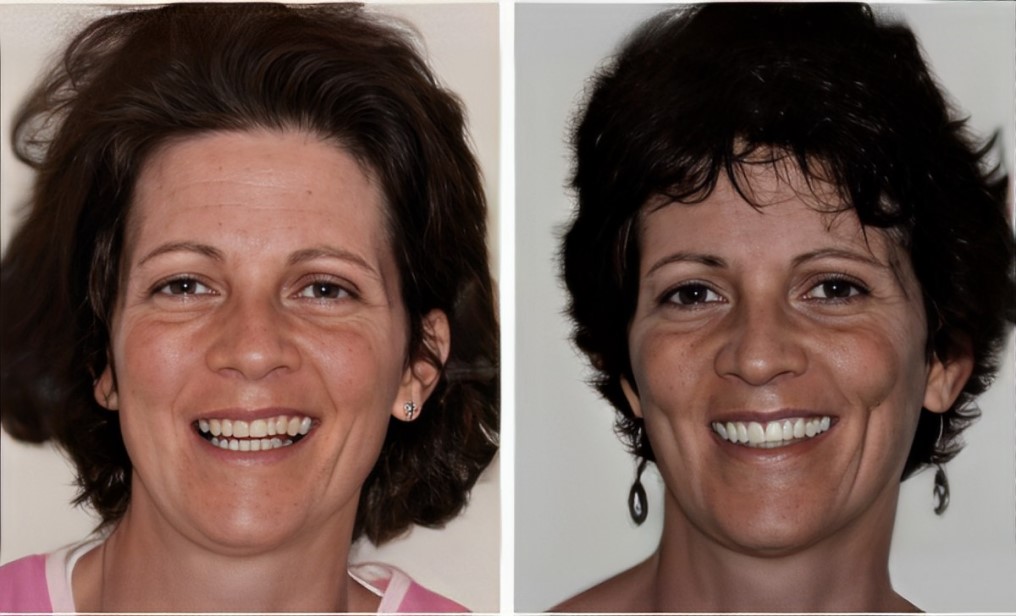Reconstructive Dentistry

Cosmetic Dentistry Procedures we offer
Your oral health is complex. It requires healthy gums, teeth, muscles and joints and if any one of those is not ideal it can lead to pain or breakdown of the chewing system. By visiting Hampton Dental Associates we have your oral health as our number one concern. We will make sure that your soft and hard tissues are in optimal shape and if not we will make suggestions to get you smiling and eating your favorite foods.
If you have pain, the time to go to the dentist is now! We can help with the smallest of problems from a cracked tooth to a cavity before a tooth is lost. By performing minimally invasive dentistry and diagnosis at the right time we can save your teeth. If we must lose a tooth we can perform bone grafting so implant placement is easier and less costly. Earlier is better. Any problem that you have should be addressed as soon as it is found. Missing teeth can result in bone loss which can be difficult to rebuild so early discussions with Dr. Rick can save you from more complicated dentistry later.
Bone Loss
Chewing produces a lot of pressure on your teeth and the surrounding bone. If the number of teeth changes such as after an extraction, the other teeth work harder. This can lead to more fractures and more tooth loss. Also, if teeth are removed and not replaced, bone will resorb. Teeth need pressure and forces for the bone to be stimulated and stay healthy.

Taking out teeth is like taking the cork out of a bathtub and watching the water disappear. If teeth are loss, we will address what can be done to preserve this bone. If teeth have been missing for a while, we will discuss rebuilding the bone through bone grafting techniques. When upper teeth are removed, the sinus can get bigger like a water balloon which requires sinus lifts. So it’s always great when we can discuss bone before it’s gone.
Bone Grafting
Bone grafting is a procedure performed to increase the amount of bone in a part of the jaw where the bone has been lost. The bone may be taken from elsewhere in the body and surgically fused to the existing bone in the jaw, or synthetic bone graft material may be used.
Dental bone grafting can be done in a number of ways and Dr. Winter will discuss what is required for each situation. When possible, we will use your own bone as a donor but there are times when bone bank bone may be needed. This is known as an autograft. This method promotes faster healing.
Bone grafting is usually necessary if the patient has lost one or more teeth or has gum disease. This has created the bone loss that requires rebuilding to successfully place a dental implant or an implant-supported denture or snap-on partial.
Root Canals
Root canals get a bad reputation. They are a painless procedure that allow us to save teeth that have had cavities or have been fractured. In a single visit the tooth is anesthetized, the nerve removed and the tooth rebuilt and often our patients fall asleep during the procedure as it is very relaxing.
Patients seem to believe the root canal procedure is painful, where their pain is actually caused by the infection that has invaded the nerve chamber of the tooth and is impacting the nerve fibers. It is this pain that is making the root canal necessary, and the procedure will remove the pain. In fact, most root canals aren’t started when the tooth is “hot” or hurting. We use medication to calm the tooth down and then the anesthetic works like a dream and the tooth is treated painlessly.
A root canal is actually a tooth lifesaver, as without one the infected tooth will need to be extracted. In a root canal procedure, a small hole is created in the top of the tooth and all of the contents of the pulp chamber on the inside of the tooth are removed. This includes blood vessels, nerve fibers, and the pulp inside the tooth. The interior of the tooth is then fully cleaned and filled with a material called gutta percha, and the tooth is sealed with a composite filling. A crown (which covers the tooth like a beautiful white thimble) is then placed over the tooth to maintain and ensure strength for biting and chewing. Thanks to the root canal the patient can keep his or her natural tooth, often for the remainder of their life.
Dental Implants
Dental implants are the ultimate reconstructive dentistry procedure as they replace missing or extremely damaged teeth with dental implants. The implant consists of the titanium “implant,” which is a screw-shaped prosthetic that is screwed down into the hole formerly occupied by the natural tooth root. Because the body accepts titanium, it then grows jawbone mass around the implant, making it fully a part of the jawbone, a process known as “osseointegration”. Once this is complete, a post is added to the dental implant and then an artificial tooth (crown) is attached to the post. The completed dental implant now feels and functions just like a natural tooth, and it will often last the remainder of the patient’s life.

Dental implants can be used to replace a single tooth or multiple teeth. In certain instances, several implants can hold in a denture or a partial denture, eliminating the need for messy glue and denture adhesive. If patients want ultimate comfort and esthetics an entire arch of teeth can be replaced with dental implants and a bridge! Full mouth bridges on implants are a beautiful way to regain chewing forces, esthetics, and confidence. In the past, dentists would make dentures and partials and people would be taking their teeth out every night to clean them and put them in a water bath. Now with modern techniques and planning, we can provide “fixed” teeth that stay in and don’t need to be removed.
What People Say About Us!
I am thankful for this practice and have had a great experience through the dental implant process. Dr. Rick treats his patients as a partner in the dental plan and treatment. He takes time for educational moments so patients understand the importance of the procedures he recommends. This office is the best dental office I have experienced and highly recommend them to all. They are community minded and have been in their location many years. – W.S 10/2021
Click here to read more reviews.
Gum Disease Treatment
If your home hygiene is less than diligent, plaque and tartar can make their way under the gumline. This irritates the gum tissue, a process known as gingivitis. It’s like having little slivers of calculus deposits that cause bleeding around your teeth. This is the early stage of gum disease. At this point, the process is easy to reverse. Dr. Winter may need to perform some root scaling and root planing (this is the removal of the slivers and may be done with laughing gas or anesthetic if needed,) to remove the tartar and plaque from under the gums, but the gums and oral health can easily return to normal.
But if left unaddressed, early gum disease will progress as the bacteria cause more and more havoc. The gums will begin to pull away from the teeth and pockets will form. These are perfect places for more bacteria to accumulate. Now the irritation of gingivitis has moved into full-blown gum disease, called periodontitis. The gums are fully receding, exposing the tooth roots, which don’t have the protective enamel that the upper part of the tooth has. The bacteria begin to attack the roots and the connective tissues holding the teeth in place, so the teeth begin to loosen and fall out. It is when patients have bad breath, bad taste and bad odor and cannot reach the bacteria at the deepest parts of the pockets that periodontal Oral surgery is now necessary to keep the patient from losing many or all of his or her teeth. As mentioned above, gum disease will also cause the patient’s jawbone mass to degrade. Loss of teeth can give people’s faces that dished in appearance. They have their nose and chin get closer together and cause more wrinkles around their mouth, cheeks and nose. We work really hard to fix these issues and regaining your smile and youth is our priority. Please see our photo gallery and videos to learn about how to avoid these problems and fix your problems before they get too complex.
What Causes Bone Loss around Teeth?
Swollen or bleeding gums, gum recession, pain when you chew, loose teeth. These are all signs that you may be losing the bone structure that supports optimal oral health and appearance. There are two specific reasons bone loss may occur. One is that you lose one or more teeth. According to studies, a person may lose up to 25 percent of the bone tissue beneath a missing tooth within one year of that tooth falling out or being extracted. After that time, the bone continues to wear down, potentially at a lower rate. The reason that bone loss occurs secondary to tooth loss is that the jawbone is preserved and strengthened when you chew. Chewing sends vibrations down through teeth roots and into the jawbone, where the stimulation prompts bone regeneration.
The other reason bone loss may occur around a tooth or teeth is that gum infection has continued for too long without adequate care. Gingivitis is the mild form of gum disease that you often hear about. Without treatment, this can become periodontal disease. Periodontitis, inflammation in the deeper gum tissue and around the roots of teeth, can damage the jawbone, leading to degradation through unrelenting bacteria. This same issue can develop around dental implants, in which case it's referred to as peri-implantitis.
Bone loss is treatable in many cases and may be an important aspect of reconstructive care using dental implants and crowns, bridges, or dentures. Dr. Rick Winter has considerable training and experience in the areas of implant and reconstructive dentistry. While bone loss can sound serious, it's an issue that we can help you address successfully.
When Should I Get Treatment for Gum Disease?
Ideally, we would love to see you avoid gum disease altogether for your entire lifetime. This is possible when you maintain regular dental visits at six-month intervals and when this care is coupled with good daily oral hygiene. That said, the best time to seek treatment for gum disease is at the earliest sign of inflammation. It can be somewhat tricky to spot these early signs. You have to be on the lookout for things like chronic bad breath and bleeding gums. If you receive care for these subtle conditions, you stand a good chance of reversing the problem quickly. Signs that your gum inflammation is progressing to infection include teeth that appear longer (gum recession) and occasional pain when you brush or eat. Your teeth may also feel sensitive due to irritation around the roots.
Here at Hampton Dental Associate, SC, you can expect to receive the utmost care. We know the consequences of gum disease and quickly work to restore and protect your oral health.
Don't wait to schedule a visit with us, especially if it's been a while since your last dental checkup or you're experiencing signs that you may need reconstructive dentistry services. Reconstructive dentistry can restore comfort and also give you back a smile that you're proud to share!
Call 414-464-9021 for information on any of our services.
Check out our Dental Blog >>
Read our Patient Case Studies >>
Hampton Dental Associates is proud to offer affordable dentistry programs to help you regain your perfect smile.
Learn more about our affordable dentistry options.



